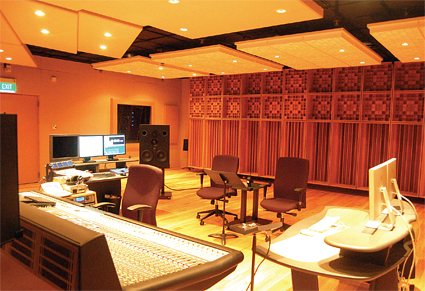Exploring the Properties of Acoustical Materials

When you think of an acoustical material, what comes to mind? Maybe some kind of dark gray foam glued to a wall? Perhaps orange shag carpeting? Or how about those square-foot white, perforated wall and ceiling panels, with or without pencils sticking out of them?
Materials used for controlling acoustical energy in a room have a much wider range than these kinds of absorbers. (Although professionally designed acoustic foam and tiled ceiling or wall panels are still very useful, I hope that the shag carpeting went out with the 1970s.)
ABSORPTION
In addition to absorption, acoustical materials can also provide reflection and diffusion. Let's look at each of these three.
Absorbing materials, as the word implies, reduce or "soak up" acoustic energy when sound hits the material. These materials are constructed of a porous material like foam or specially constructed fiberglass, often covered in some kind of fabric, or a porous form like those white ceiling tiles.
As a designer, you will need to know how much absorption the material, mounted in a particular way, provides across its effective frequency range. Graphs plotting absorption vs. frequency are very helpful.
Sound absorption is measured in Sabins, named after the pioneering architectural acoustician, Wallace Clement Sabine. One Sabin is equal to one square foot of an ideal material that totally absorbs all sound. Sound absorption can also be expressed as an absorption coefficient, calculated by dividing the number of Sabins of the material by its area in square feet.

A teaching control room at the University of Singapore uses diffusion canopies overhead in the rear of the room for additional diffusion, as well as reflection control from the ceiling with back-loaded absorptive material. Photo by RPG Diffusor Systems Inc. and The Yong Siew Toh Conservatory of Music, University of Singapore In reality, materials tend to absorb only a certain percentage of sound energy and reflect or diffuse the energy not absorbed back into the room.
Laboratory measurements of absorption coefficients are performed in true reverberant chambers and calculated based on how much the chamber's reverberation time is reduced with the material inserted in the room.
This must be kept in mind when materials measured in true reverberant spaces are applied to small rooms, such as typical control rooms that don't contain enough volume to develop statistical reverberant fields.
In these smaller rooms, you are usually trying to control specific instances of acoustical sound energy, such as early reflections or later-arriving echoes, which could detrimentally color the sound heard by the sound mixer and other listeners.
Mounting, placement, size and depth all matter when installing any kind of acoustical control material.
Sound absorption of a particular material can be extended to lower frequencies, if mounted away from a wall (with an air space between the material and the wall). The thicker and larger the material, in general, the more effective it will be at lower frequencies.
REFLECTION
If you have specific problem reflections you wish to absorb, identify where these reflections are coming from by careful listening or through acoustical measurements. Then treat only the offending surfaces.
If you need control over a wider area, the temptation may be to install a whole lot of absorption. But that can create an unnatural type of listening environment, a room that's too dead.
DIFFUSION
Which brings us to diffusion.
Diffusing materials scatter the sound hitting the material. Diffusion is dependent on the size of the surface compared to the wavelength of the impinging sound, as well as the design of the material and geometry of the surface.
Diffusors can range from cylindrical shaped forms, to highly sophisticated mathematically derived forms.
Sound scattering can take the form of lobing, with peaks and nulls at different angles to the incident angle of the sound, changing in shape, level, and geometry with different frequencies. In the more sophisticated designs, the scattered sound is denser and more evenly distributed over the entire angular range and over a wider frequency range, than simpler shapes.
Diffusors can be designed to work primarily in one plane, such as horizontally, or in both horizontal and vertical directions.
An indication of how much diffusion a surface provides is given by a diffusion coefficient. Defined in AES-4id-2001 (r2007), "the diffusion coefficient characterizes the sound reflected from a surface in terms of the uniformity of the scattered polar distribution." This is derived from a free-field measurement.
Further the AES information document states "the diffusion coefficient is a measure of quality designed to be used by producers and users of surfaces that, either deliberately or accidentally, diffuse sound. It is also intended for use when needed by developers and users of geometric room acoustic models."
In addition to having this single number when considering different products, it's also very helpful to have graphs showing the sound scattering at different angles of incidence and at different frequency bands.
The last type of acoustical material is a reflector. This is a material where the angle of incidence of an impinging sound source is equal to the angle of reflection. This can occur with a very flat and smooth surface that is large compared to the acoustic wavelength. The reflected sound can often remain little changed in frequency and level compared to the incident sound.
While we usually try to minimize surfaces that reflect sound back to the mixer and listeners, reflectors can be useful in redirecting sound to absorbers or diffusers.
With this understanding of the three basic properties of acoustical materials, a designer can better select products that help meet design goals or fix acoustical problems.
Mary C. Gruszka is a systems design engineer, project manager, consultant and writer based in the New York metro area. She can be reached via TV Technology.
The professional video industry's #1 source for news, trends and product and tech information. Sign up below.
